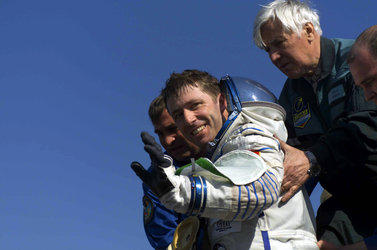25 April
2002: On 25 April 2002, an ESA astronaut was launched to the International Space Station (ISS) when the 'Marco Polo' flight and its crew of three lifted off from Baikonur, Kazakhstan at 12:26 local time.
Italian astronaut Roberto Vittori, a former Italian Air Force test pilot, and his fellow crew members Yuri Gidzenko, the mission commander, and flight participant Mark Shuttleworth, South Africa's first person in space, would dock with the space station two days later on 27 April.
The crew arrived at the ISS, some 400 kilometres above the Earth's surface, completing the mission's prime task of delivering a new Soyuz spacecraft.
It is essential for the resident crew that the Soyuz 'lifeboat' remains in top condition in case of an emergency evacuation and so regular 'taxi' missions, such as Marco Polo, are used to swap an older Soyuz spacecraft with a newer craft every six months.
Vittori, the first Italian astronaut to fly on a Russian Soyuz, was the third European astronaut to visit the space station and during his eight-day stay would work alongside the resident crew - Expedition Four commander Yuri Onufrienko and flight engineers Dan Bursch and Carl Walz - and oversee four European experiments.
These looked at the forces involved in moving around in microgravity and the effects on humans of cosmic particles during long missions, assessed newly developed clothing, and tested a non-intrusive blood pressure monitoring device.

1982: On 25 April 1982, ESA's COS-B mission, due to last two years, was finally switched off. It had functioned successfully for 6 years and 8 months. COS-B was the first ESA mission to study gamma-ray sources. Its results created a catalogue of these sources, known as the 2CG Catalogue.















 Germany
Germany
 Austria
Austria
 Belgium
Belgium
 Denmark
Denmark
 Spain
Spain
 Estonia
Estonia
 Finland
Finland
 France
France
 Greece
Greece
 Hungary
Hungary
 Ireland
Ireland
 Italy
Italy
 Luxembourg
Luxembourg
 Norway
Norway
 The Netherlands
The Netherlands
 Poland
Poland
 Portugal
Portugal
 Czechia
Czechia
 Romania
Romania
 United Kingdom
United Kingdom
 Slovenia
Slovenia
 Sweden
Sweden
 Switzerland
Switzerland


































